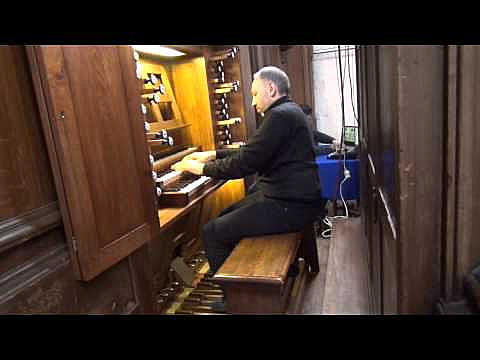



ORGUES DE PARIS © 2025 Vincent Hildebrandt ACCUEIL LES ORGUES

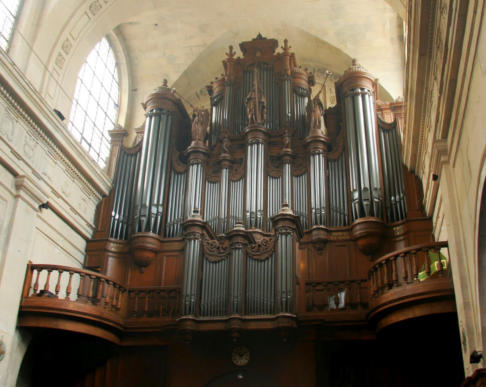

L'orgue de facture « traditionnelle» et « moderne «
L'orgue de Suret est un instrument dont la facture
comporte de nombreuses caractéristiques des siècles
passés (anches, cornet, plein jeu) ainsi qu’un certain
nombre d’ innovations caractéristiques de la première
moitié du 19ème siècle (à l'exception des machines
Barker, qui n'ont jamais été installées). La facture
empruntée de l’ « ancien régime » est démontré par
Christophe d'Alessandro, organiste titulaire de la Ste
Elisabeth, dans des œuvres de Louis Couperin (1626-
1661), Auguste Bazille (1828-1891, premier Titulaire de
Sainte Élisabeth) et Félix Foudrain (1880- 1923, ancien
titulaire de Sainte Élisabeth).
L'orgue de Ste Elisabeth est équipé de microphones à
l'intérieur des cinq œuvres de l'orgue et de haut-
parleurs derrière l'orgue pour permettre un mélange
du son d'orgue traditionnel avec des sons électroniques
en direct. De nouvelles technologies de traitement
audio et vidéo en temps réel sont ainsi utilisées pour
augmenter / modifier le son d'un orgue. Le son de
l'orgue est capté, modifié et distribué dans l'espace en
temps réel. Le réel et le virtuel se mélangent dans
l'espace acoustique de l'église. L'orgue augmenté est
joué par l'organiste (Christophe d'Alessandro, organiste
titulaire de Ste Elisabeth) et par le musicien qui
contrôle le traitement et la diffusion en temps réel du
son de l'instrument (Markus Noissternig, compositeur
de musique informatique et électrique et audio
ingénieur).
L’aspect de la facture « moderne » est démontré par
trois improvisations.
Explication de l’orgue augmentée

F3
Le Grand-orgue a été construit par Antoine Suret en 1852-
1853. Il fut exposé à l'Exposition Universelle de 1855 comme
un exemple de belle facture d'orgues parisienne. Il a
remporté un premier prix, sans doute grâce à son buffet, qui
est alors très exubérant pour l’époque. C'est l'un des rares
orgues de ce facteur encore présent à Paris. L'instrument est
caractéristique de cette période dite de « transition »(pré-
romantique), avec de nombreux jeux d’anches (16 sur 39),
dont trois comportant des anches libres : Euphone, Cor
Anglais et le Hautbois (aujourd'hui disparu). L’instrument
abrite également un jeu de Kéraulophone, dont l’invention
est attribuée à Gray & Davison (Londres, 1843).
L'orgue a été profondément modifié par G. Gutschenritter au
début du XXe siècle (vers un style plus symphonique) et en
1941-1955 (vers un style plus néoclassique avec changement
de traction, devenue pneumatique).
Relevé en 1976 par Philippe Hartmann, le positif fut restauré
en 1985 par Théo Haerpfer.
Il fut reconstruit à l’identique en 1994-1999 par Giroud.
Brochure
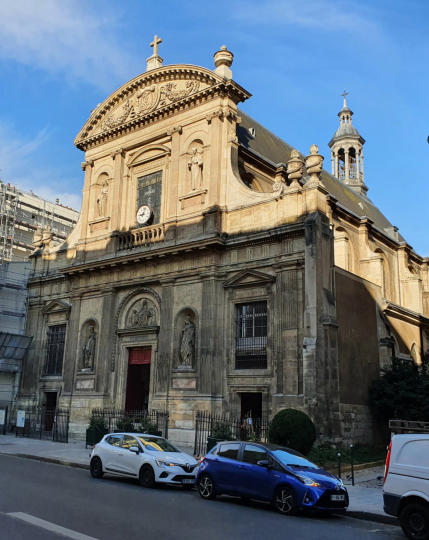
Cette ancienne chapelle conventuelle (affectée à l’ordre
des Franciscains) a été dédiée à sainte Élisabeth de
Hongrie en 1646. Elle a été construite par l'architecte
Paul de Gonde. Sa façade classique comporte des
éléments doriques et ioniques. Lors du percement de
la rue Turbigo, sous Napoléon III, l'église a perdu sa
chapelle de la Vierge. Dans le chœur se un très beau
retable flamand en bois du début du XVIIe siècle,
provenant de l'ancienne abbaye de Saint-Vaast d'Arras.
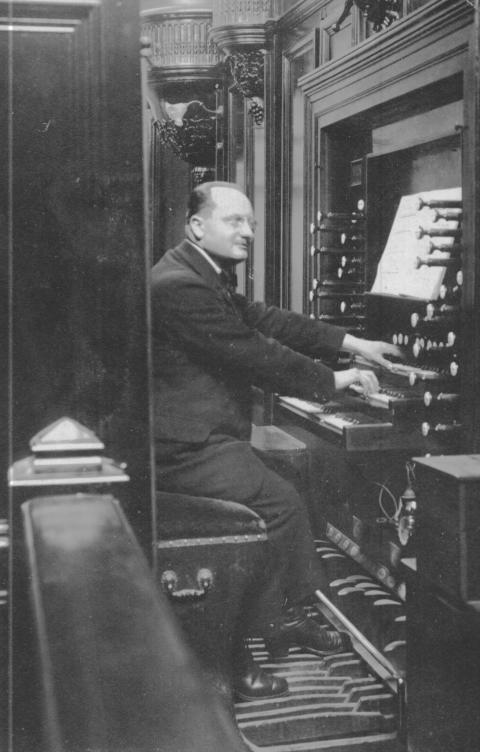
Console disparue
(Facebook Xavier Lebrun)
Organiste : peut-être Felix Fourdrain
1853 - Suret (1)
19xx/41/55 - Gutschenritter (3a)
1976 - Philippe Hartman (6)
1985 - Haerpfer (6)
1994-99 - Michel Giroud (4)
III/39 - traction mécanique
composition
Organiste titulaire
Christophe d'Alessandro
Concerts
Irrégulièrement
Messes avec orgue
Samedi à 18h30, Dimanche à 11h
Vidéo
Christophe d'Alessandro
Photos: Jeroen de Haan
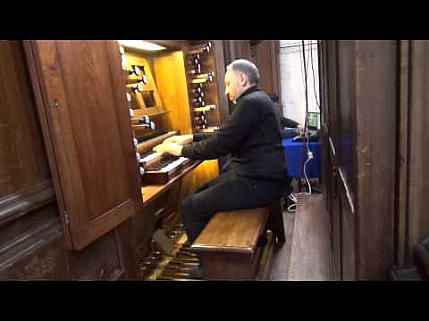
Les orgues de Paris
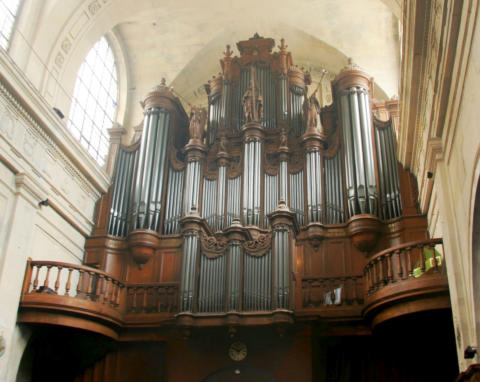
ORGUES DE PARIS © 2025 Vincent Hildebrandt LES ORGUES
F3
Le Grand-orgue a été construit par Antoine Suret en 1852-
1853. Il fut exposé à l'Exposition Universelle de 1855 comme
un exemple de belle facture d'orgues parisienne. Il a
remporté un premier prix, sans doute grâce à son buffet, qui
est alors très exubérant pour l’époque. C'est l'un des rares
orgues de ce facteur encore présent à Paris. L'instrument est
caractéristique de cette période dite de « transition »(pré-
romantique), avec de nombreux jeux d’anches (16 sur 39),
dont trois comportant des anches libres : Euphone, Cor
Anglais et le Hautbois (aujourd'hui disparu). L’instrument
abrite également un jeu de Kéraulophone, dont l’invention
est attribuée à Gray & Davison (Londres, 1843).
L'orgue a été profondément modifié par G. Gutschenritter au
début du XXe siècle (vers un style plus symphonique) et en
1941-1955 (vers un style plus néoclassique avec changement
de traction, devenue pneumatique).
Relevé en 1976 par Philippe Hartmann, le positif fut restauré
en 1985 par Théo Haerpfer.
Il fut reconstruit à l’identique en 1994-1999 par Giroud.
Brochure
Organiste titulaire
Christophe d'Alessandro
Concerts
Irrégulièrement
Messes avec orgue
Samedi à 18h30, Dimanche à 11h
Vidéo
Christophe d'Alessandro
Photos: Jeroen de Haan
L'orgue de facture « traditionnelle» et « moderne «
L'orgue de Suret est un instrument dont la facture comporte
de nombreuses caractéristiques des siècles passés (anches,
cornet, plein jeu) ainsi qu’un certain nombre d’ innovations
caractéristiques de la première moitié du 19ème siècle (à
l'exception des machines Barker, qui n'ont jamais été
installées). La facture empruntée de l’ « ancien régime » est
démontré par Christophe d'Alessandro, organiste titulaire de
la Ste Elisabeth, dans des œuvres de Louis Couperin (1626-
1661), Auguste Bazille (1828-1891, premier Titulaire de Sainte
Élisabeth) et Félix Foudrain (1880- 1923, ancien titulaire de
Sainte Élisabeth).
L'orgue de Ste Elisabeth est équipé de microphones à
l'intérieur des cinq œuvres de l'orgue et de haut-parleurs
derrière l'orgue pour permettre un mélange du son d'orgue
traditionnel avec des sons électroniques en direct. De
nouvelles technologies de traitement audio et vidéo en
temps réel sont ainsi utilisées pour augmenter / modifier le
son d'un orgue. Le son de l'orgue est capté, modifié et
distribué dans l'espace en temps réel. Le réel et le virtuel se
mélangent dans l'espace acoustique de l'église. L'orgue
augmenté est joué par l'organiste (Christophe d'Alessandro,
organiste titulaire de Ste Elisabeth) et par le musicien qui
contrôle le traitement et la diffusion en temps réel du son de
l'instrument (Markus Noissternig, compositeur de musique
informatique et électrique et audio ingénieur).
L’aspect de la facture « moderne » est démontré par trois
improvisations.
Explication de l’orgue augmentée
1853 - Suret (1)
19xx/41/55 - Gutschenritter (3a)
1976 - Philippe Hartman (6)
1985 - Haerpfer (6)
1994-99 - Michel Giroud (4)
III/39 - traction mécanique
composition
